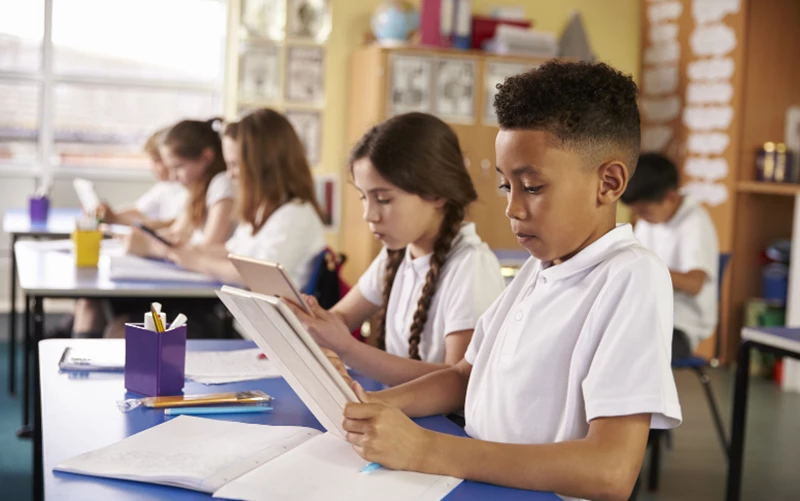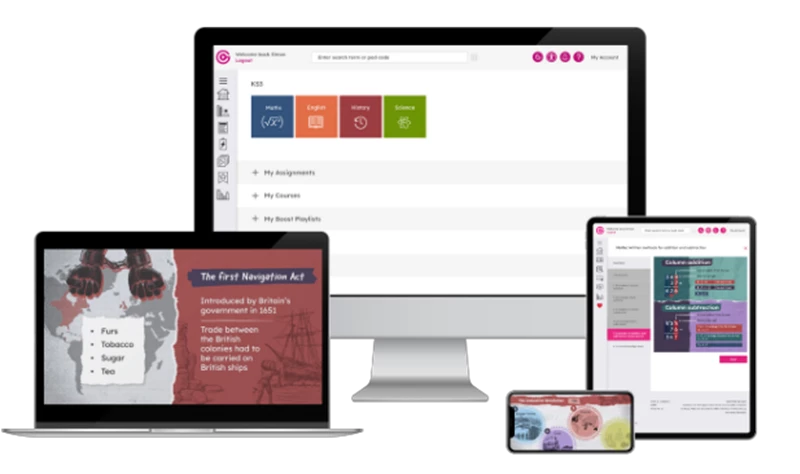-
- Curriculum content & assessment
- Overview
- Key Stage 3
- GCSE
- GCSE resits
- Functional skills
- Nationals
- International
- Pricing
- Customer stories
- Guides & webinars

Gamification in education: Revolutionising teaching through engaging experiences
If you’re an educator in today’s world, you’ll have no doubt asked yourself, “How can I meet the needs of my tech-savvy learners?”
With technology evolving at such a rapid pace, we’re having to re-evaluate traditional teaching methods. Today, virtual learning platforms are commonplace and blended learning styles are gaining popularity. Amidst this transformation, gamification in education emerges as a potential innovator.
 3 minutes
3 minutes

Written by Emma Slater - Curriculum, Teaching & Learning Expert
Gamification in education, empowering students!
While some worry about the addictive and competitive nature of games, we know gamification has the power to:
- Transform a pupil’s performance
- Captivate minds
- Enhance motivation and engagement
And it can empower students to take charge of their learning journey.
In this article, we’ll explore how gamification is reshaping the way our pupils learn. We'll also look at how it can unlock a world of engaging possibilities for students of all ages.
What is covered on this page:
- The concept of gamification in education: a catalyst for student engagement
- Gamification techniques: Strategies for effective learning enhancement
- Gamification in education Empowering personalised teaching
- Implementing gamification in classroom settings: practical approaches
- The future of gamification in education: trends and innovations
The concept of gamification in education: a catalyst for student engagement
Gamification in education blends elements of gaming with educational content. This creates an immersive experience.
Game mechanics such as points, badges, levels, and leaderboards tap into student’s intrinsic motivation. This encourages active participation and engagement.
It also fosters a sense of competition, collaboration, and accomplishment. Ultimately, students will invest more time and effort into their studies.
Gamification in education also provides a safe space for trial and error, allowing pupils to make mistakes and learn from them.
Bottom line, gamification:
- Enhances knowledge retention
- Improves problem solving and critical thinking skills
- Makes learning a captivating experience
Let's take a closer look at its definition

Understanding gamification: definition and principles
Gamification is the practice of applying gaming elements to otherwise non-game contexts. It’s proven to have a positive impact on productivity and participation.
Core principles of gamification in education include:
- Points
- Rewards
- Achievements
These signify accomplishment, levels to measure progress, and leaderboards for friendly competition. Additionally, feedback features encourage improvement, while learning challenges maintain interest.
Game-based activities have always been a firm favourite in the classroom. These include board games, number games and puzzles. However, digitisation in schools has resulted in more creativity within ‘online classrooms’. This has resulted in a new wave of interactive software, online quizzes and video learning.

Benefits of gamification in educational environments
There are many benefits to this technology-driven teaching strategy.
The top five benefits of gamification in learning:
- Boosts student engagement and motivation
- Makes learning more immersive and enjoyable
- Enhances retention and problem-solving skills
- Promotes a sense of achievement
- Builds a safe space for experimentation
In the next section, we’ll pick apart some of these benefits.
Psychological motivators behind gamified education
Gamification in learning is more than just a fun activity; it has the ability to tap into the inner workings of our mind.
These psychological motivators include:
Intrinsic motivation. By infusing challenges and granting autonomy, gamification ignites the enjoyment of learning. Imagine your students eagerly taking charge of their educational journey.
Extrinsic rewards. We all love to be acknowledged and rewarded for our efforts. Gamified learning incorporates extrinsic rewards. These include badges and points, giving students a sense of accomplishment and recognition. These rewards act as little boosts, pushing students to go the extra mile and achieve more.
Social Elements. We’re social creatures, and gamified learning capitalises on this innate need for connection. Leaderboards and collaborative projects create a sense of belonging within the classroom. Students thrive in a supportive community where healthy competition and teamwork flourish.
Stickiness of Information. Ever wonder why certain things are easier to remember? Well, gamified learning holds the answer. Through repetition and engagement, information becomes more memorable. Students absorb knowledge as they interact with game-like activities. This ensures a deeper understanding of the subject matter.
Gamification techniques: Strategies for effective learning enhancement
Point-based systems can motivate students towards a learning objective or key development stage. Plus, pupils and parents are more comfortable with using online tools. In fact, the vast majority are able to access the internet at home. This means that schools are now in a position to flexibly incorporate gamification in learning.
Digital learning and online learning content work best when built into a school’s wider e-learning strategy – and when used to support more traditional teaching methods. Digital tools that avoid cognitively overloading students can help embed knowledge and learning.
Progress and development can be tracked, and rewards can be given to continually motivate the learner. We know increased engagement leads to better outcomes. And, with gamification, pupils want to know more, achieve more and feel confident in what they are learning.
Points, badges, and leaderboards: Fostering competition and rewards
Gamification in learning allows students to earn points and badges for their achievements. This motivates them towards excellence and a desire to climb the leaderboard. It also promotes a healthy sense of competition.
Quests and challenges: Promoting goal-oriented learning
In the classroom, quest-like challenges can ignite a sense of enthusiasm in a pupil’s learning journey. Gamification in education allows students to embark on quests and conquer challenges. This propels them towards educational goals.
These goal-orientated experiences infuse learning with purpose and excitement.
Role-playing and simulations: Creating immersive experiences
Role-playing and simulations promote active learning and empathy. This is achieved by allowing participants to assume different roles and scenarios. In education, students can explore historical events or complex concepts through firsthand engagement.
Overall, role-play and simulations captivate minds, enhancing a deeper educational understanding and enjoyment.
Gamification in education: Empowering personalised education
Gamification in leducation enables teachers to tailor content to individual needs. This is through clear development indicators and markers throughout usage. The outcome: a greater environment for educational excellence and learning success.
Gamified systems can identify knowledge gaps and highlight strengths and weaknesses.
In other words, gamified systems give students control over their own learning. And it can offer clarity for you, the educator.
Adaptive learning through gamified systems
Utilising highly-responsive technology, gamified systems adjusts content based on individual progress. As students navigate through challenges, earn rewards and receive real-time feedback, engagement soars. This personalised approach enhances comprehension and retention.
This allows learners to grasp concepts at their own pace. With adaptive learning, you can ensure every pupil reaches their potential.
Individual progress tracking and feedback
Personal development monitoring and individualised feedback are pillars of effective learning. With these tools, students, teachers and parents can:
- Monitor academic progress
- identify areas for improvement
- Maintain motivation
Real-time feedback offers valuable insights. It guides learners towards success and a sense of accomplishment.
A dashboard is a great way to track and monitor engagement. It's visual, user-friendly and packed with accurate data. What's more, its exportable.
You can see what marks each pupil has achieved, as well as the average mark for your class.
With 'usage data' on an individual and group level, you can identify which students need extra support and interventions.
Customised learning paths and personalised content
When it comes to customisation, avatars are highly effective. Placing learners at the very heart of the game, they allow students to feel more engaged in their learning. Users can also customise their avatars in ways that appeal to them.
This tailored approach not only enhances motivation but it encourages frequent gameplay. It empowers learners to be enthusiastic about their personal wins.
Implementing gamification in classroom settings: practical approaches
We recommend delivering three-to-five-minute bursts of high-quality audio-visual learning. This approach can engage learners without overwhelming them. Gamified learning platforms are a great way to support this approach. They can support, reinforce and ingrain traditional learning methods.
Students can work through the digital content in two ways: at their own pace or via your direction. If you decide to take the lead, you can set assignments, recommend content and mark assessments.
Gamified assessments: making testing engaging and interactive
Incorporating quizzes, challenges and rewards drives active student participation and engagement in assessments.
For GCSE students, our 'Check And Challenge Software' promotes learning, not just testing.
And our gamified assessments help create a positive learning environment. Students can navigate their way to the correct answers while providing scaffolded support along the way.
For teachers, these assessments provide meaningful and actionable feedback. This leads to accelerated progress and saved time.
Collaborative gamification: promoting teamwork and peer learning
Incorporating gamification in group activities is also effective. Students are working together towards a common goal. These interactive challenges foster effective communication, problem solving, and collaboration among peers. As learners strategise, share ideas and support each other, they:
- Deepen their understanding of the subject matter
- Develop essential interpersonal skills
Collaborative gamification in learning creates a dynamic and inclusive learning environment. Students can thrive through cooperation and mutual growth.
Gamification for classroom management: enhancing discipline and participation
As you’ll know, not everyone likes to follow the rules. When you transform these rules into game mechanics, students can earn rewards. This is far more incentivising than academic success alone.
What’s more, you can reward good classroom etiquette and participation. This encourages positive behaviour and demonstrations of responsibility.
The future of gamification in education: trends and innovations
As you might have guessed, gamification in learning isn’t going to become stagnant; it’s here to stay and will evolve as technology advances. Here are our predictions on how gamification will leap forward within the next two, five and ten years.
Virtual reality and augmented reality in gamified education
VR and AR is not exactly a novel concept in the classroom. You may even have access to headsets that can be used to help support some of your Curriculum areas.
However, VR/AR in the classroom is still fairly small-scale in it use. You may have used it to help you teach a Science lesson; you may have used it to allow students to ‘step back in time’ in History. But let’s face it, do you have enough headsets for your whole class of 30+ learners? Does the tech really help make your job easier?
Over the next few years, advanced headsets will improve in quality and reduce in cost. Technology will develop, and access to immersive content will become easier and more affordable.
Mobile gamification: learning anytime, anywhere
Smartphones and tablets are becoming more and more common in households. Over the next few years, this will only increase further. This will provide opportunities for learners to engage in games, quizzes and challenges on-the-go.
Education will become a flexible and engaging experience that fits into their busy lives.
AI and gamification: personalised learning with intelligent systems
With a classroom full of pupils, personalised learning can be an unrealistic target. Even more so if you have limited resources. But, with the right learning software, AI and intelligent systems can develop unique experiences for each student. This will allow you to be much more personalised in your approach.
Our Boost playlist, for example, identifies knowledge gaps for each student. It provides them with a personalised report on their academic strengths and areas for improvement. It then automatically generates a content playlist closely matched to their weakest areas. This technology gives students control over their own learning. And you have the ability to place greater emphasis on individual progress.

